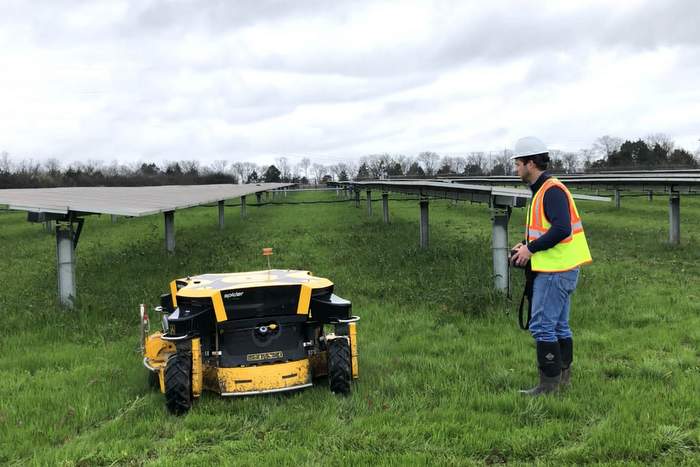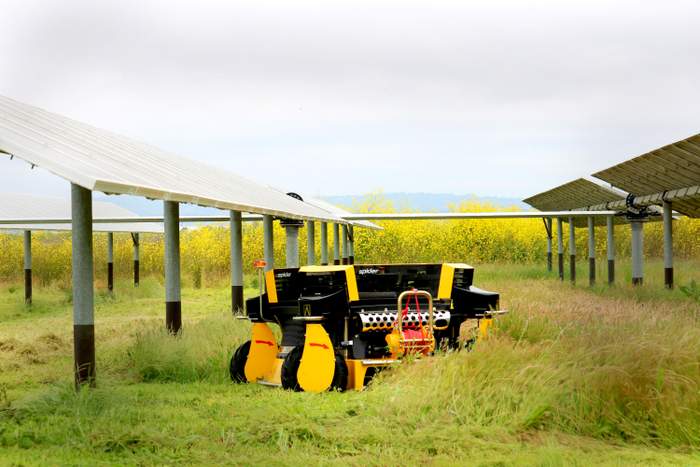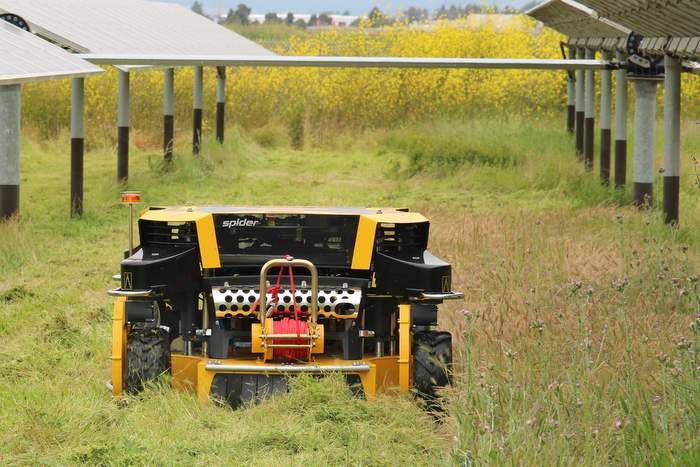The following white paper was sent our way by By Bri Bruce, marketing manager for AutoMow.
Though the topic is often overlooked in comparison to other plant concerns, vegetation control is an important consideration for utility-scale PV plant operation and maintenance. Unchecked vegetation growth can lead to shading of the panels, which in turn decreases the plant’s productivity. Even a small amount of shading can significantly reduce the performance of the entire solar photovoltaic system. Loss of generated energy equates to loss of income for the solar plant owner or operator, so vegetation maintenance cannot be underestimated.
Managing vegetation can be an ongoing and expensive task; however, AutoMow slope mowers by Spider were designed as a cost-effective method to keep solar PV vegetation under control. AutoMow not only makes solar PV plant mowing easier, more efficient, and safer, but the 2SGS model is specifically designed for solar vegetation maintenance, helping PV plant owners and operators maximize the lifetime value of the plant.
This white paper provides a brief summary on the benefits of maintaining a solar plant with AutoMow.
Mowing, Reimagined
AutoMow’s innovative mowers allow operators to mow where traditional mowers can’t. AutoMow significantly cuts time and resources spent on mowing the hard-to-reach areas of a solar PV plant.
The ability to control the mower remotely via a radio remote control allows for safe and comfortable mowing from a distance, giving the operator a full view of the mower and increasing operator safety by placing the operator away from noise, vibrations, fumes, and potential dangers posed by PV plants. Traditional tractor driven or zero-turn ride-on mowers can leave the operator with a significant blind spot, increasing the risk of damaging PV modules or plant wiring.
A specially engineered drive system allows omnidirectional 360-degree mowing in four-wheel drive, offering superior, uncomplicated maneuverability. AutoMow mowers are gentle on terrain and eliminate erosion on slopes. Moreover, its lightweight aluminum alloy design allows for low fuel consumption, resulting in low emissions. Machines can also be equipped with biodegradable fluids that are often required when maintaining ecologically sensitive areas.
At 5mph, and with a four-hour runtime, the 48-inch cutting and mulching deck of an AutoMow slope mower can cut 2.16 acres per hour, or 95,000 square feet, with an approximate 10% overlap. The mowers boast low downtime when refueling, and machines can be serviced in the field with a simple tool kit.
One AutoMow mower can replace multiple specialized mowers, posing an economic solution by reducing man hours and specialized machinery. Operators can immediately realize a 10X reduction in man hours, with several reports exceeding this estimate.
Deployment and transportation
AutoMow machines can be deployed quickly and easily without the need for a large equipment trailer. They can easily be transported using a pick-up truck, van, or small trailer, increasing mobility between solar sites.
Design
Because of the difficulty in operating most mowers within PV plant configurations, the Spider 2SGS model was designed specifically for solar plants. It features a lower profile, making it ideal for maintaining the turf beneath and around PV panels. By using mowing equipment that fits under the array, plant owners can eliminate any damage that would otherwise be inflicted on the PV system by traditional mowing methods.
The built-in mulching deck of the mower is designed to drop debris down, rather than to the sides of the mower. The deep, hallow mulching mowing cavity of the machine nearly eliminates the risk of rocks being kicked out and damaging modules.
It can replace multiple brush cutters or one piece of heavy machinery—at substantially lower operating costs.
Benefits of mowing and grass
Studies have shown that frequent mowing—more than once a year—is the best vegetation control technique. Frequent mowing prevents unwanted plant species from sprouting new seeds and promotes desired plant species to become well established.
If left unmanaged, vegetation can shade solar panels as well as increase the risks of tracker failure, pest infestation, and significant increases in service time. Excess amounts of dry vegetation also pose a fire hazard if a spark is created by plant equipment during a ground fault.
Some PV plant owners argue that the placement of gravel beneath panels will eliminate some risks. While laying gravel is a viable strategy, it is more expensive than planting grass and dust from the gravel can interfere with the panels’ power production—and dusty panels will require frequent washings.
Grass is cheaper to lay than gravel and is more environmentally acceptable. Grass can also improve solar production by reducing dust from gravel and cooling the ground around panels.
Herbicides
Mowing eliminates the need for herbicides, keeping harmful chemicals out of the environment.
However, the use of herbicides varies by geographic location and is permitted only where allowed by state and federal law. Mowing may be the most available means to maintain vegetation.
Replanting
Reports show that having grass on site is beneficial—and even promote the planting of grass where there is none.
During PV plant construction, grading and sloping is sometimes necessary. Grading makes installation easier while sloping helps with proper drainage. Vegetation is removed during both these processes, which increases the chance of soil erosion and can compromise the integrity, operation, and structure of the PV system. Research conducted by the US National Renewable Energy laboratory (NREL) suggests that “revegetation is not only possible but can achieve ground cover sufficient to control erosion.”
If a site is replanted, low-growing grasses are encouraged, as they prevent shading, are more manageable for maintenance, and minimize fuel loads for potential wildfires.
Conclusion
AutoMow and Spider have partnered to offer a niche product that not only realizes the needs of solar O&M providers, but continues to innovate its mowing capabilities based on the evolving technology of the solar industry. Vegetation control should be an important aspect of PV plant operation and maintenance, and integrating AutoMow into your vegetation management strategy is an efficient, cost-effective solution that eliminates the risks posed by traditional solar array mowing methods.
SOURCES:
Brenda Beatty, Jordan Macknick, James McCall and Genevieve Braus. “Native Vegetation Performance under a Solar PV Array at the National Wind.” NREL Technical Report NREL, May 2017.
Ryan Nielsen, Lynsey Tibbs and Tamara Waldmann. “Solar PV Vegetation Management Strategies.” New Energy Update.
— Solar Builder magazine



Leave a Reply
You must be logged in to post a comment.